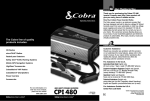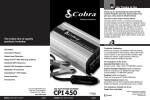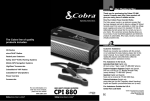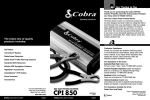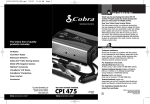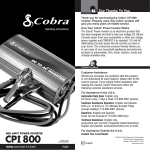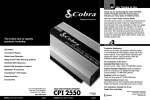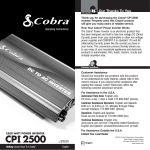Download Cobra CPI 480 Operating instructions
Transcript
Introduction Our Thanks to You Our Thanks Thank you for purchasing the Cobra to CPIYou 480 inverter. Properly used, this Cobra product will give you many years of reliable service. Operating Instructions The Cobra line of quality products includes: CB Radios microTALK® Radios Radar/Laser Detectors Safety Alert® Traffic Warning Systems Mobile GPS Navigation Systems HighGear® Accessories CobraMarine® VHF Radios CobraMarine® Chartplotters Power Inverters Accessories 400 WATT POWER INVERTER CPI 480 How Your Cobra Power Inverter Works The Cobra power inverter is an electronic product that has been designed and built to take low voltage DC (Direct Current) power from your automobile or other low voltage power supplies and convert it to standard 115 Volt AC (Alternating Current) power like the current you have in your home. This conversion process thereby allows you to use many of your household appliances and electronic products in automobiles, RVs, boats, tractors, trucks and virtually anywhere else. Introduction Important Safety Information Important Safety Information Before installing and using your Cobra power inverter, please read these general precautions and warnings. Caution and Warning Statements To make the most of this inverter, it must be installed and used properly. Please read the installation and operating instructions carefully before installing and using it. Special attention must be paid to the CAUTION and WARNING statements in the manual. CAUTION Statements specify conditions which could cause damage to the unit or other equipment. WARNING Statements identify conditions that could result in personal injury or loss of life. General Precautions 1. Never install the inverter in a boat’s engine compartment where gas and battery fumes are present. 2. Do not operate the inverter if it has been dropped or damaged in any way. 3. Do not open the inverter; it contains no userserviceable parts. Attempting to service unit could cause electrical shock. NOTE Internal components remain charged after all power is disconnected. 4. Do not expose the inverter to rain, snow, bilge water or spray. 5. Do not obstruct the ventilation openings. 6. Do not install the inverter in zero-clearance compartment. CAUTION This inverter should be used in negative ground applications only. • Introduction Important Safety Information WARNING Power inverters contain components that can produce arcs or sparks. To prevent fire or explosion, do not install the inverter in areas or compartments containing batteries or flammable materials or in locations that require ignitionprotected equipment. WARNING To reduce the risk of fire, do not cover or obstruct the ventilation openings. Do not install inverter in zero-clearance compartment. Warning: Wash Hands After Handling Power Cord The power cord on this product contains lead, a chemical known in the state of California to cause birth defects or other reproductive harm. Caution: Rechargeable Appliances Certain chargers for small nickel cadmium batteries can be damaged if connected to the Cobra 400 watt inverter. Two particular types of equipment are prone to this problem: 1. Small battery-operated appliances Plug In Directly such as flashlights, razors, and night lights that can be plugged directly into an AC receptacle to recharge. 2. Certain battery chargers for Dangerous Voltages battery packs used in hand power tools. These chargers have a WARNING label stating that dangerous voltages are present at the battery terminals. This problem does not occur with the vast majority of battery operated equipment. Most use a separate charger or transformer that is plugged into the AC receptacle and produces a low voltage output. If the label on the AC adapter or charger states that it produces a low voltage AC or DC output (less than 30 volts), the inverter will have no problem powering the adapter safely. Introduction Quick Evaluation Before Installation Cobra 400 Watt Output Waveform Some very sensitive electronic equipment may not operate satisfactory on “square wave” or “modified sine wave.” The output waveform is referred to as “square wave” or “modified sine wave.” It is a stepped waveform designed to have characteristics similar to the sine wave shape of utility power. A waveform of this nature is suitable for most AC loads (including linear and switching power suppliers used in electronic equipment, transformers and motors). Quick Evaluation Before Installation • This section provides you with basic information about the inverter and how to check its performance before installation. Be sure to have on hand: A 12 volt DC power source (such as a vehicle battery). The power source must provide Power Supply between 11 and 15 volts DC and be able to supply enough current to run the test load. As a rough guide, divide the wattage of the test load by 10 to get the current (in amperes) the power source must deliver. The provided two foot cigarette lighter cable and two foot direct-to-battery 12 gauge cable. Only use the cables provided with your inverter. The cigarette lighter cable is suitable for operating the inverter at loads up to 150 watts. Connect by securely inserting the plug into the cigarette lighter socket. Cig. Lighter Cable 12 Gauge Cable CAUTION Do not use the cigarette lighter cable for loads higher than 150 watts. When connecting loads larger than 150 watts, please connect the inverter directly to the battery. Introduction Quick Evaluation Before Installation A test load that can be plugged into the AC receptacle on the inverter for short term testing at a low power level. To check your inverter’s performance before installation: 1. Turn the inverter off (see page 11 On/Off Switch to Off for details). If the power source is a DC power supply, switch it off as well. 2. Connect cables to power input terminals (see page 6 Connect Terminals for details). 3. Connect cable to power source (see page 8 for details). 4. Check to make sure all connections are secure. Connect Power Source 5. Turn the inverter on. If the power source is a DC power supply, switch it on first. 6. Plug in the test load. Test Load On/Off Switch to On Connect Test Load USB Connection The inverter should supply power to the load. If the inverter is not working properly, refer to the troubleshooting guide on page 14 or power and protection indicators section on page 12. Installation Installation Requirements Installation Requirements The inverter must be installed in an area that meets all of the following requirements: A. Dry Do not place in an area where water can drip or splash on the inverter. B. Cool Ambient air temperature should be between 30°F and 105°F (0°C and 40°C). The cooler the better. C. Ventilate Allow at least one inch (three cm) of clearance around the inverter for proper airflow. Make sure that ventilation openings on the ends of the unit are not obstructed. • CAUTION To avoid fire, do not cover or obstruct ventilation openings. Do not install inverter in a zeroclearance compartment. Overheating may result. CAUTION The inverter must only be connected to batteries with a nominal output voltage of 12 volts. It will not work with a 6 volt battery, and will be damaged if it is connected to a 16 volt battery. WARNING This unit contains components which can produce arcs or sparks. To prevent fire or explosion, do not install in compartments containing a battery or flammable materials, or in a location which requires ignition protected equipment. Installation Mounting and Connecting Cables Installation Connecting Cables To mount your inverter: 1. Place the inverter on a flat surface with the mounting bracket against the mounting surface. 2. Connect cable to the Power Input Terminals on right side panel of the inverter. The red terminal is positive (+) and the black terminal is negative (-). Insert the ends of the cables onto the terminals and tighten the screws to clamp the cables safely. Mounting Brackets Connect Terminals 2. Mount to secure surface using mounting hardware that is corrosion resistant (not included). 3. Connect cable to your vehicle’s cigarette lighter socket. Mounting • Connect Power Source Mounting Hardware The inverter can be mounted horizontally or vertically. Connecting Cables • Power wire and wiring are very important to the performance of the inverter. Because the inverter has a low voltage, high current input, low resistance wiring is essential between the battery and inverter. This is so it can deliver the maximum amount of energy to the load. Only use the cables provided with your power inverter. To connect the cables between On/Off Switch to Off the inverter and the battery: 1. Turn the On/Off Switch on the inverter to the off position. If the power source is a DC power supply, switch it off as well. NOTE If the inverter is to be used at levels above 150 watts for extended periods of time, a direct connection to the battery is recommended. Do not use the cigarette cord for loads higher than 150 watts. Please contact your local dealer or customer assistance for the proper cord for direct to battery connections. CAUTION Reverse polarity connections (positive to negative) will blow inverter fuses and may permanently damage the unit. Such damage is not covered by the warranty. CAUTION Remove any jewelry (watch, ring, etc.). Be careful not to short circuit the battery with any metallic object (wrench, etc.). Installation Connecting Cables WARNING You may observe a spark when making the connection because current can flow to charge the capacitors in the inverter. Do not make this connection in the presence of flammable fumes. Explosion or fire may result. Thoroughly ventilate the battery compartment before making this connection. 3. Connect cable to the power source: a. Connect the cable from the Negative (Black) Terminal of inverter to the Negative Terminal of the power source. Make a secure connection. b. Connect the cable from the Positive (Red) Terminal of the inverter to the Positive Terminal of the power source (the battery’s main fuse or the battery selector switch, if you are using one). Make a secure connection. You might observe a spark when you make this connection since current can flow to charge capacitors in the inverter. All power connections to your Cobra inverter must be Positive to Positive and Negative to Negative. Installation Connecting Cables CAUTION Do not connect the inverter and another AC source (such as a generator or utility power) to the AC wiring at the same time. The inverter will be damaged if its output is connected to AC voltage from another source. Damage can even occur if the inverter is switched off. CAUTION Do not connect the inverter to an AC branch circuit that has high-power consumption loads. It will not operate electric heaters, air conditioners, stoves, and other electrical appliances that consume more than 400 watts. CAUTION Loose connectors result in excessive voltage drop and may cause over heated wires and melted insulation. CAUTION Reverse polarity connections (positive to negative) will blow external fuse in the inverter and may permanently damage the unit. Such damage is not covered by the warranty. CAUTION Remove any jewelry (watch, ring, etc.). Be careful not to short circuit the battery with any metallic object (wrench, etc.). Connect Power Source WARNING 115 volt AC power is potentially lethal. Do not work on AC wiring when it is connected to the inverter (even if it is switched off) unless the DC power source is physically disconnected from the inverter. Also, do not work on AC wiring if it is connected to another AC power source such as a generator or the utility line. WARNING You may observe a spark when making the connection because current can flow to charge the capacitors in the inverter. Do not make this connection in the presence of flammable fumes. Explosion or fire may result. Thoroughly ventilate the battery compartment before making this connection. Installation Power Consumption Power Consumption • For each piece of equipment you will be operating from the inverter, you must determine the battery’s reserve capacity (how long the battery can deliver a specific amount of current — in automotive batteries, usually 25 amperes) or ampere-hour capacity (a measure of how many amperes a battery can deliver for a specified length of time). Example – Reserve capacity: a battery with a reserve capacity of 180 minutes can deliver 25 amperes for 180 minutes before it is completely discharged. Example – Ampere-hour capacity: a battery with an ampere-hour capacity of 100 ampere-hours can deliver 5 amperes for 20 hours before it is completely discharged. To determine the battery ampere-hour capacity you require: 1. Determine how many watts each piece of equipment consumes. This can normally be found on the product label. If only the current draw is given, multiply the current draw by 115 to get the watt consumption. 2. Estimate the time (in hours) that each piece of equipment will be running between battery charging cycles. 3. Calculate the total watt-hours of energy consumption (power x operating time) using the average power consumption and the total estimated running time (in hours). Power x Operating Time = Watt-Hours. Laptop 50 watts x 2 hours = 100 watt-hours TV/VCR (up to 25") 115 watts x 3 hours = 345 watt-hours Blender 300 watts x 15 minutes = 75 watt-hours 4. Divide the watt-hours by 10 to determine how many power supply’s (12 volt) ampere-hours will be consumed. Operation Power On and Off Turning Your Inverter On or Off • Be sure to have your power inverter properly installed before attempting to turn the unit on (see installation page 5). To turn the power inverter on: On/Off Switch to On 1. If a DC power supply is being used as the power source, switch it on. 2. On the left side panel, switch the On/Off Switch to on. The inverter is now ready to deliver AC power to your loads. If several loads are to be operated by the inverter, turn them on separately, after the inverter has been turned on. This will ensure that the inverter does not have to deliver the starting currents required for all the loads at once. To turn the power inverter off: On/Off Switch to Off 1. On the left side panel, switch the On/Off Switch to off. NOTE The On/Off Switch turns the control circuit in the inverter on and off. It does not disconnect power from the inverter. When the switch is in the off position, the inverter draws no current from the battery. When it’s in the on position, but no power is being supplied to the load, the inverter draws less than 500 milliamperes from the battery. This is low current draw. It would take more than a week to discharge a 100 amperehour battery at this rate depending on the age of the battery. Operation Power and Protection Indicators Power and Protection Indicators The power and protection indicators include a green light, a red light and an alarm. Green Light Power on – The green light should remain on steady. Red Light and/or Alarm Current overload – The red light will blink continuously, then the inverter will shutdown. The inverter will continue to check for appropriate current levels while trying to restart the load. DC input voltage overload – The red light will turn on and the inverter will shutdown. The inverter will continue to check for appropriate voltage levels while trying to restart the load. DC input voltage shortage – As a warning that the voltage is getting low, the internal alarm will sound. When the voltage is too low, the inverter will shutdown and the red light will turn on. The inverter will continue to check for appropriate voltage levels while trying to restart the load. Temperature overload – The red light will blink, then the inverter will shutdown. The inverter will continue to check for appropriate temperature levels while trying to restart the load. NOTE A momentary sound of the internal alarm and/or flash of the red light is normal at start up. Operation • Operating Limits Operating Limits • Power Output The inverter can deliver 400 watts for about 60 minutes. The inverter must cool for 15 minutes before it can resume operation at 400 watts. Note: The wattage rating applies to resistive loads. The inverter will operate most AC loads within its power rating. Some induction motors used in freezers, pumps, and other motor-operated equipment require very high surge currents to start. The inverter may not be able to start some of these motors even though their rated current draw is within the inverter’s limits. The inverter will normally start single phase induction motors rated at one-half HP or less. Input Voltage The inverter will operate from input voltage ranging from 10 volts to 15 volts. Optimum performance will occur when the voltage is between 12 volts and 14 volts. If the voltage drops below 10.5V+/-0.3V, an audible low battery warning will sound. The inverter will shut down if the input voltage drops below 9.5V+/-0.3V. This protects the battery from being over-discharged. It will restart when the input voltage exceeds 12V+/-0.3V. The inverter will also shut down if the input voltage exceeds 15.75V+/-0.75V. This protects the inverter against excessive input voltage. Although the inverter has protection against over-voltage, it may still be damaged if the input voltage were to exceed 16 volts. Operation Troubleshooting Guide Troubleshooting Guide • Solution Problem/Symptom Possible Causes Reduce the load. Low output voltage Overload No output voltage Low input voltage Recharge battery. Check connections and cable. Allow inverter No output voltage Thermal to cool off. after prolonged use shutdown Reduce load, continuous operation input current required. Improve ventilation; Make sure ventilation openings in the inverter are not obstructed. Reduce ambient temperature. Make sure No output voltage, High input the inverter is “Protect” indicator voltage connected to lighted 12V battery. Check regulation of charging system. Check load for No output voltage Short circuit proper operation. Replace fuse. Blown fuse No power to inverter Check Low battery alarm Poor DC wiring connections. on all the time Make sure battery Poor battery is fully charged. condition COBRA RADAR DETECTORS Operation Specifications Specifications • Continuous output power (1 hour) . . . . . . . . . . . . 400W Surge rating (0.1 second) . . . . . . . . . . . . . . . . . . . 800W Peak efficiency (12V – 1⁄2 load) . . . . . . . . . . . . . . > 88% Efficiency (full load, 12V) . . . . . . . . . . . . . . . . . . . > 83% No load current draw . . . . . . . . . . . . . . . . < 0.5A (12.6V) Output waveform (resistive load) . . . Modified sine wave Output frequency . . . . . . . . . . . . . . . . . . . . 58HZ – 62HZ Output voltage . . . . . . . . . . . . . . . . . . . . . . 109V – 120V USB output . . . . . . . . . . . . . . . . . . . . . . . . . . . . . . . . . 5V Input voltage . . . . . . . . . . . . . . . . . . 10.4VDC – 14.4VDC Alarm voltage (unload) . . . . . . . . . . . . . . .10.2V – 10.8V Shutdown voltage (unload) . . . . . . . . . . . . . 9.2V – 9.8V Operating temperature range . . . . . . . . . . . . 0°C – 40°C (32°F – 104°F) Storage temperature range . . . . . . . . . . . . -40°C – 85°C (-40°F – 185°F) Protection . . . . . . . . . .Overload, short-circuit, overtemp, reverse polarity, under/over voltage Notes All protection is automatically recovered. To protect the battery, if the unit needs to be restarted after low voltage protection, the voltage of DC input should be above 12V. To extend the life of the fan, it will stop when there is no load. The speed of the fan increases as the load increases. The unit is completely insulated in input and output for added safety. GPS RADAR DETECTOR









